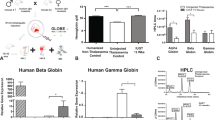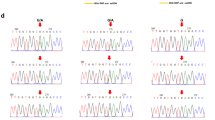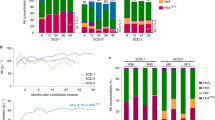Abstract
The goal of the present study was to analyze if sustained delivery of elevated doses of recombinant erythropoietin (Epo), by genetically modified and immunoprotected allogeneic cells, was able to correct the chronic anemia, characteristic of a spontaneous mouse model of β-thalassemia (Hbb thal 1). Mouse C2C12 myoblast cells were transfected with a plasmid containing the mouse Epo cDNA and a mutated dihydrofolate reductase (DHFR) gene for gene amplification upon administration of increasing doses of methotrexate. In order to immunoprotect the transplanted cells, the stably modified cells were loaded into polyethersulfone microporus hollow fibers which were implanted subcutaneously into Hbb thal 1 mice. An increase in hematocrit starting 2 weeks after implantation was associated with elevated blood levels of Epo and an improved red blood cell phenotype. The latter indicated an improvement of cell morphology and membrane defects, in particular a reduced amount of free α hemoglobin chain, the hallmark of globin chain imbalance in β-thalassemia. A reduction of reticulocyte count contrasting with the increase in hematocrit was also observed suggesting an improved erythrocyte survival. We conclude that the phenotype can be durably improved in some β-thalassemic mice upon in vivo delivery of recombinant Epo by polymer encapsulated cells. Sustained elevated delivery of recombinant Epo holds promise for the treatment of β-thalassemia-associated chronic anemia.
This is a preview of subscription content, access via your institution
Access options
Subscribe to this journal
Receive 12 print issues and online access
$259.00 per year
only $21.58 per issue
Buy this article
- Purchase on Springer Link
- Instant access to full article PDF
Prices may be subject to local taxes which are calculated during checkout



Similar content being viewed by others
References
Johnson FM, Lewis SE . Electrophoretically detected germinal mutations induced in the mouse by ethylnitrosourea Proc Natl Acad Sci USA 1981 78: 3138–3142
Skow LC et al. A mouse model for β thalassemia Cell 1983 34: 1043–1052
Yang B et al. A mouse model for β0-thalassemia Proc Natl Acad Sci USA 1995 92: 11608–11612
Ciavatta DJ, Ryan TM, Farmer SC, Townes TM . Mouse model of human β0 thalassemia: targeted deletion of the mouse βmaj- and βmin-globine genes in embryonic stem cells Proc Natl Acad Sci USA 1995 92: 9259–9263
Leroy-Viard K, Rouyer-Fessard P, Beuzard Y . Improvement of mouse β thalassemia by recombinant human erythropoietin Blood 1991 78: 1596–1602
Sauvage C, Rouyer-Fessard P, Beuzard Y . Improvement of mouse β thalassemia by hydroxyurea Br J Haematol 1993 84: 492–496
Rouyer-Fessard P et al. Mouse β thalassemia, a model for the membrane defects of erythrocytes in the human disease J Biol Chem 1990 265: 20247–20251
Sorensen S et al. The role of membrane skeletal-associated-α-globin in the pathophysiology of β thalassemia Blood 1990 75: 1333–1340
Curcio MJ et al. Compensatory increase in levels of β minor globin in murine β thalassemia is under translational control J Biol Chem 1986 261: 16126–16135
Alter BP, Campbell AS, Holland JG, Friend C . Increased mouse minor hemoglobin during erythroid stress: a model for hemoglobin regulation Exp Hematol 1982 10: 754–760
Whitney BJ III . SI/SId and W-Wv adult mice have fetal and neonatal levels of mouse minor hemoglobin. In: Stamatoyannopoulos G, Nienhuis A (eds) . Hemoglobin in Development and Differentiation Liss: New York 1981 281–286
Anderson WF et al. Attemps at gene therapy in β-thalassemic mice Ann NY Acad Sci 1985 445: 445–451
Rodgers GP et al. Augmentation by erythropoietin of the fetal-hemoglobin response to hydroxyurea in sickle cell disease New Engl J Med 1993 328: 73–78
Al-Khatti A et al. Stimulation of fetal hemoglobin synthesis by erythropoietin in baboons New Engl J Med 1987 317: 415–420
Cazzola M, Mercuriali F, Brugnara C . Use of recombinant human erythropoietin outside the setting of uremia Blood 1997 89: 4248–4267
Loukopoulos D . New therapies for the haemoglobinopathies J Int Med 1997 242: 43–48
Villeval JL et al. Retrovirus-mediated transfer of erythropoietin gene in hematopoietic cells improves the erythrocyte phenotype in murine beta-thalassemia Blood 1994 84: 928–933
Naffakh N et al. Sustained delivery of erythropoietin in mice by genetically modified skin fibroblasts Proc Natl Acad Sci USA 1995 92: 3194–3198
Rinsch C et al. A gene therapy approach to regulated delivery of erythropoietin as a function of oxygen tension Hum Gene Ther 1997 8: 1881–1889
Naffakh N et al. Long-term secretion of therapeutic proteins from genetically modified skeletal muscles Hum Gene Ther 1996 7: 11–21
De Franceschi L et al. Combination therapy of erythropoietin, hydroxyurea and clotrimazole in a β thalassemic mouse: a model for human therapy Blood 1996 87: 1188–1195
Descamps V et al. Erythropoietin gene transfer and expression in adult normal mice: use of an adenovirus vector Hum Gene Ther 1994 5: 979–985
Svensson EC et al. Long-term erythropoietin expression in rodents and non-human primates following intramuscular injection of a replication-defective adenoviral vector Hum Gene Ther 1997 8: 1797–1806
Tripathy SK, Black HB, Goldwasser E, Leiden JM . Immune responses to transgene-encoded proteins limit the stability of gene expression after injection of replication-defective adenovirus vector Nature Med 1996 2: 545–549
Snyder RO et al. Efficient and stable adeno-associated virus-mediated transduction in the skeletal muscle of adult immunocompetent mice Hum Gene Ther 1997 8: 1891–1900
Déglon N et al. Central nervous system delivery of recombinant ciliary neurotrophic factor by polymer encapsulated differentiated C2C12 myoblasts Hum Gene Ther 1996 7: 2135–2146
Author information
Authors and Affiliations
Rights and permissions
About this article
Cite this article
Dalle, B., Payen, E., Regulier, E. et al. Improvement of mouse β-thalassemia upon erythropoietin delivery by encapsulated myoblasts. Gene Ther 6, 157–161 (1999). https://doi.org/10.1038/sj.gt.3300812
Received:
Accepted:
Published:
Issue Date:
DOI: https://doi.org/10.1038/sj.gt.3300812
Keywords
This article is cited by
-
Kidney Mesenchymal Stem Cell‐derived Extracellular Vesicles Engineered to Express Erythropoietin Improve Renal Anemia in Mice with Chronic Kidney Disease
Stem Cell Reviews and Reports (2022)
-
Cell encapsulation technology as a novel strategy for human anti-tumor immunotherapy
Cancer Gene Therapy (2011)
-
Therapeutic applications of polymeric artificial cells
Nature Reviews Drug Discovery (2005)
-
Establishment of an oriP/EBNA1-based episomal vector transcribing human genomic β-globin in cultured murine fibroblasts
Gene Therapy (2002)
-
Streptogramin-based gene regulation systems for mammalian cells
Nature Biotechnology (2000)



